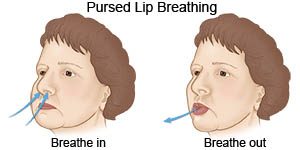Exercise can be beneficial for lung cancer survivors by increasing strength and endurance and decreasing emotional issues. Physical activity may help the lung cancer survivor tolerate their cancer treatments and lower their fatigue level.
The thought of exercise might be overwhelming to those with lung cancer, but a well-designed exercise program may help them feel better physically and mentally, and it may also decrease the risk of further disease. Being physically active appears to improve survival and quality of life.
The side effects of lung cancer surgery and treatments are detrimental to the health and the quality of life of lung cancer patients. Patients are at increased risk of osteoporosis, cardiovascular disease, and many other health problems. My work with this population as well as other research confirms that exercise helps to mitigate the side effects of cancer treatment and surgery.
An exercise program must be gentle and progress slowly, especially if the patient had been sedentary prior to the diagnosis. For the inactive, it is a good time to begin using gentle exercises. All patients should receive medical clearance before starting to exercise. It is important to note that having a compromised immune system would make it unsafe to exercise in a large gym. The lung cancer patient should start out working with a physical therapist, pulmonary rehabilitation specialist or a cancer exercise specialist.
Shortness of breath and difficulty breathing can keep the patient from exercise and cause them to be sedentary. Thus it is important to start the exercise program with breathing exercises. Restoring breathing will help endurance and quality of life and will enable the patient to accomplish activities of daily living.
Breathing exercises or pulmonary rehab is important for patients with advanced lung cancer with the goal of improving breathing capacity and quality of life. The effects of pulmonary rehab have also been studied in patients with lung cancer prior to and following surgical resection. This research has demonstrated significant improvements in the six-minute walk distance and lower extremity strength.
The lung cancer patient should learn diaphragmatic breathing through pursed lips. Diaphragmatic breathing strengthens the diaphragm and the abdominal muscles. This will allow more air to move in and out of the lungs without tiring the chest muscles. When the diaphragm becomes weak, the patient compensates by using the shoulders and other muscles to help them breathe.

Breathing with pursed lips is beneficial and can be used with the diaphragmatic breathing. The hand is placed on the abdomen. The patient should inhale through the nose while gently pushing the abdomen out. The hand on your abdomen moves outward. This allows the diaphragm to lower enabling one to increase lung capacity. The patient should then exhale slowly using pursed lips while gently pushing inward and upward with the hand to help empty the lungs completely. The navel is pressed to the spine while exhaling all the air out.
Pursed-lip breathing should be practiced several times a day. In addition to strengthening the abdominal muscle, it will help regulate breathing if one becomes short of breath particularly during an activity. This type of breathing will help the ability to get through an activity.
Patients with shortness of breath and limited breathing capacity due to their cancer should perform stretching exercises daily to increase lung capacity. Stretching will help to keep the chest muscles lose and encourage deep breathing. Light stretching is a great way to improve range of motion.
Stretching can also help improve your posture. Sitting down all day at a desk or driving can cause the shoulders to round forward and kyphosis, which can decrease lung capacity.
Dr. Gerard A. Silvestri, Dr. Brett Bade, and colleagues at Medical University of South Carolina have reviewed the safety, benefits, and application of increasing physical activity and exercise in lung cancer with the goal to summarize the effect on improved lung cancer outcomes. Their results are published in the Journal of Thoracic Oncology, the official journal of the International Association for the Study of Lung Cancer (IASLC).They found that physical activity should be considered as a therapeutic option for patients with lung cancer as exercise and physical activity have been shown to reduce symptoms, improve quality of life, increase exercise tolerance, and decrease length of hospitalization and post-surgery complication of lung cancer.
Carol J. Michaels is the founder and creator of Recovery Fitness® LLC, located in Short Hills, New Jersey. Her programs are designed to help cancer survivors in recovery through exercise programs. Carol, an award winning fitness and exercise specialist, has over 17 years of experience as a fitness professional and as a cancer exercise specialist.
References
Pouwels et al. Preoperative exercise therapy in lung surgery patients: Respir Med. 2015 Aug 15. pii: S0954-6111(15)30041-X.
Blanchard, C. et al. Cancer survivors’ adherence to lifestyle behavior recommendations and associations with health-related quality of life: results from the American Cancer Society’s SCS-II. Journal of Clinical Oncology. 2008. May 1;26(13):2198-204.
Cramp, F. et al. Exercise for the management of cancer-related fatigue in adults. Cochrane Database of Systematic Reviews 2008. 2008. Apr 16;(2):CD006145.
Forman, M. Diet and physical activity in lung cancer risk prediction for current, former, and never smokers. 2007. AACR Meeting Abstracts Online.
Rivas et al. Integrating pulmonary rehabilitation into the multidisciplinary management of lung cancer. Respir Med. 2015 Apr;109(4):437-42.
Liu, W. et al. Breathing exercises improve post-operative pulmonary function and quality of life in patients with lung cancer: A meta-analysis. Experimental and Therapeutic Medicine. 2012. 5(4):1194-1200.
Kuer, L et al. Exercise in Patients With Non–Small Cell Lung Cancer. Med Sci Sports Exerc. 2014;46(4):656-663.
